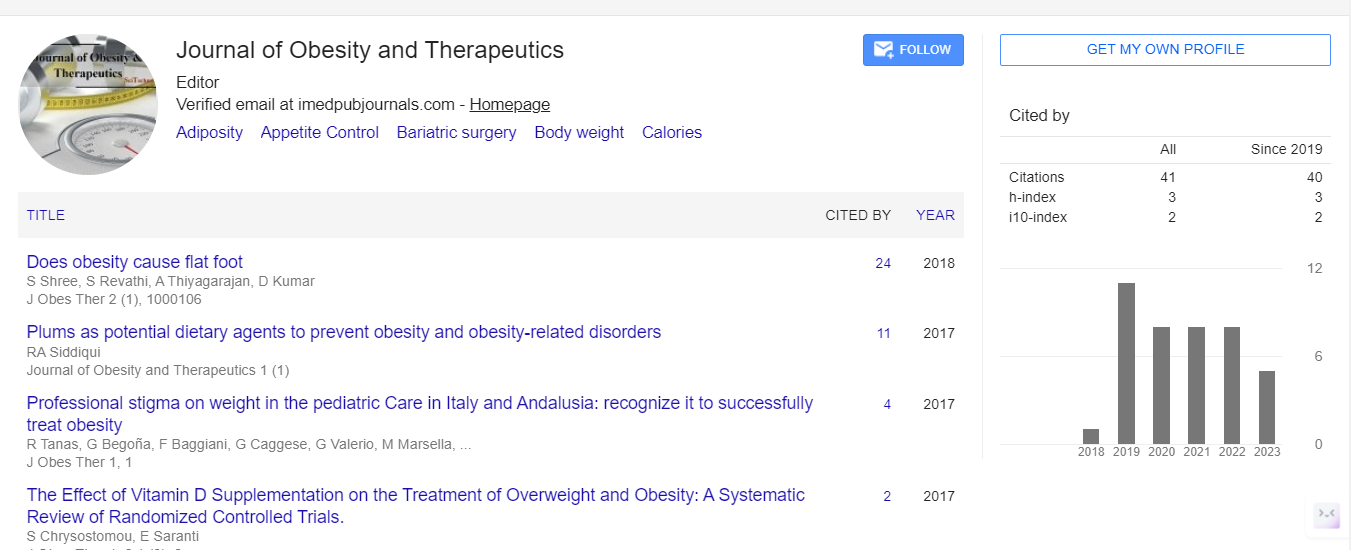Perspective, J Obes Ther Vol: 5 Issue: 3
Obesity and Malnutrition - Ways to Prevent Obesity Related Malnutrition
Konstantinos Kantartzis*
Division of Endocrinology, University of Tubingen, Germany
- *Corresponding Author:
- Konstantinos Kantartzis
Division of Endocrinology, University of Tubingen, Germany
E-mail:konstantiosk334@gmail.com
Received Date: November 08, 2021; Accepted Date: November 23, 2021; Published Date: November 30, 2021
Citation: Kantartzis K (2021) Obesity and Malnutrition - Ways to Prevent Obesity Related Malnutrition. J Obes Ther 5:3. 114.
Copyright: © All articles published in Journal of Obesity & Therapeutics are the property of SciTechnol, and is protected by copyright laws. Copyright © 2020, SciTechnol, All Rights Reserved.
Keywords: Obesity, Malnutrition, Lipogenesis
Perspective
The aetiology of obesity is apparently easy to understand, people consume extra energy than they expend, with the extra power being saved in adipose tissue. Public fitness campaigns consequently promote nutritional restraint and physical exercise, and emphasize character responsibility for those behaviours. Increasingly, however, researchers are switching from thermodynamic to metabolic models of obesity, thereby clarifying how particular environmental factors promote lipogenesis. Obesity can best be explained now no longer with the aid of using counting ‘calories in and out’, however by knowledge how specific dietary products and activity behaviours perturb cellular metabolism and promote net lipogenesis. This metabolic technique can moreover be incorporated with extra state-of-the-art models of ways commercial practices drive the consumer developments that promote obesogenic behaviours. Notably, obesity remedy has validated more effective if it bypasses individual responsibility, suggesting that a comparable technique putting much less emphasis on individual responsibility might enhance the efficacy of obesity prevention. Successful obesity prevention campaigns are possibly to emerge most effective whilst the general public receive better ‘protection’ from the economic practices which are using the worldwide obesity epidemic. Rather than populations failing to heed governments’ public health advice, governments are presently failing the general public with the aid of using forsaking their obligation for regulating commercial activities.
‘Overweight’ and ‘obesity’ are phrases enmeshed in debates over standards to be hired in special ethnic groups. Body mass index (BMI), a ratio of weight and top, is the traditional degree. It is expressed as weight in kilograms divided with the aid of using a squared degree of height in metres. A BMI of much less than 18 is labelled as underweight, among 18 to twenty-five as regular body weight, from 25 to 30 as overweight and over 30 as obese. These Western requirements are nevertheless extensively used for international comparisons. Overweight and obesity are related to growing fitness hazard because of diabetes, heart attacks, stroke, most cancers and plenty of different diseases.
BMI, whilst used as a trademark of excess weight, is typically interpreted to be because of extra body fats (adipose tissue). It need not constantly be so, as a very muscular athlete can have a excessive BMI without excessive body adiposity. Even persons with excessive bone weight can be labelled as overweight without a high degree of body fats. However, BMI has come to be the maximum generally used measure for characterising overweight and obesity in people and populations, and a surrogate for unwanted ranges of body fats.
Obesity is a type of malnutrition. Malnutrition is resulting from eating a diet wherein vitamins aren’t sufficient or an excessive amount of such that it causes health problems. It entails calories, proteins, carbohydrates, vitamins, and minerals. Deficiency of those vitamins is referred to as under nutrition and an excessive amount of of vitamins are referred to as over nutrition. Over nutrition can bring about obesity and being obese. In a few developing countries, over nutrition with inside the shape of obesity is a primary malnutrition associated problem. In the USA wherein for almost all of people, get admission to to food isn’t always an issue and that they have access to the excess of non-nutritious meals similarly to growth sedentary life styles. Over consuming may end in many metabolic diseases, along with diabetes, coronary heart disorder and a few types of cancers which could bring about death. A diet of pizza, fries, crisps, pasta, desserts and plenty of different junk meals eating a number of calories however few nutrients that lead malnutrition.
The processed meals are the maximum famous reason of weight problems, Processed meals are filled with excessive fructose corn syrup, refined flours, and Tran’s fat are excessive in calorie however poor in lots of critical nutrients like proteins, vitamins, and minerals reason metabolic disorder diseases.
In general, meals are stripped in their nutrients in the course of the refining process. All the vitamins, minerals, antioxidants and fibre are present with inside the outer layer of grains that loose in the course of the refining process. Refined meals also are wealthy in calorie however poor in different nutrients.
Ways to Prevent Obesity Related Malnutrition
Eat extra vegetables: Eat more plant based meals along with entire grains, fruits, vegetables, nuts, seeds, beans, and so forth that prevent weight problems/obese. They are excessive in vitamins, minerals, antioxidants, anti-inflammatory compounds, fibre and essential fatty acids.
Opt for healthy oils: Eat a healthful plant primarily based totally fat along with olive oil, sunflower oil, rice bran oil, canola oil, mustard oil, soybeans oil, vegetable oil, flax, nuts and seeds to maintain the stability of fats with saturated, mono unsaturated and poly unsaturated fatty acids with inside the body.
Eat lean meat: Intake of lean mass animal protein along with fish, lean meat, chicken, egg, etc., is the great preference to save you obesity associated malnutrition.
 Spanish
Spanish  Chinese
Chinese  Russian
Russian  German
German  French
French  Japanese
Japanese  Portuguese
Portuguese  Hindi
Hindi 